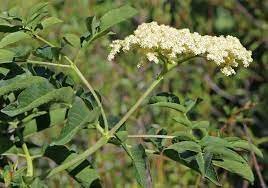 Image 1 of 2
Image 1 of 2

 Image 2 of 2
Image 2 of 2



Sambucus cerulea (Blue Elderberry)
Our native Blue Elderberry produces edible fruits in late summer , though our native songbirds usually devour them before we gardeners get around to picking them! This shrub will grow quickly - up to 30 ft. tall! - and the Blue Elderberry typically has a more small tree-like form than the shrubbier Red Elder. Blue Elderberry is also far more tolerant of full sun and dry, fast-draining soils, as you'll often see this species associated with rockier soils along cliffs and prairies. The broad, creamy-white flat-topped flower clusters appear in mid-summer (about the same time that the earlier-blooming Red Elder is producing fruits), and provide nectar for butterflies, hummingbirds, and native bees. Those flowers give way to an abundance of blue berries in late summer, which attract birds such as tanagers, waxwings, finches, and chickadees. Protect young seedlings from deer until they are tall enough to thrive without deer exclusion.
Our native Blue Elderberry produces edible fruits in late summer , though our native songbirds usually devour them before we gardeners get around to picking them! This shrub will grow quickly - up to 30 ft. tall! - and the Blue Elderberry typically has a more small tree-like form than the shrubbier Red Elder. Blue Elderberry is also far more tolerant of full sun and dry, fast-draining soils, as you'll often see this species associated with rockier soils along cliffs and prairies. The broad, creamy-white flat-topped flower clusters appear in mid-summer (about the same time that the earlier-blooming Red Elder is producing fruits), and provide nectar for butterflies, hummingbirds, and native bees. Those flowers give way to an abundance of blue berries in late summer, which attract birds such as tanagers, waxwings, finches, and chickadees. Protect young seedlings from deer until they are tall enough to thrive without deer exclusion.
